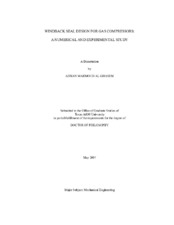| dc.contributor.advisor | Morrison, Gerald L. | |
| dc.creator | Al-Ghasem, Adnan Mahmoud | |
| dc.date.accessioned | 2007-09-17T19:30:51Z | |
| dc.date.available | 2007-09-17T19:30:51Z | |
| dc.date.created | 2003-05 | |
| dc.date.issued | 2007-09-17 | |
| dc.identifier.uri | https://hdl.handle.net/1969.1/5740 | |
| dc.description.abstract | Seals are considered one of the important flow elements of a turbomachinery device.
Traditional labyrinth seals have proven their performance functionality by reducing leakage
rates. Significant improvements on labyrinth seal functionality were obtained through altering
the design geometry of labyrinth seals to prevent contamination across a seal and maintaining
small leakage flowrates. This results in a windback seal that has only one tooth which
continuously winds around the shaft like a screw thread. These seals are used in gas compressors
to isolate the gas face seal from bearing oil. A purge gas is passed through the seal into the
bearing housing. The helical design allows the seal to clear itself of any oil contamination.
Windback seal performance is controlled through changing the seal geometry. A 2D graphical
design tool for calculating the total and cavity leakage flowrates for windback seals is
introduced.
The effectiveness of the Fluent CFD (Computational Fluid Dynamics) commercial code
to accurately predict the leakage rate for windback seals was evaluated. The objective is to
determine if CFD simulations can be used along with a few experimental tests to study windback
seals of this design with air as the working fluid. Comparison of measurement and predictions
for a windback seal using the κ-ε turbulence model with enhanced wall treatment functions show
predictions and measurements comparing very well with a maximum difference of 5% for
leakage rate. Similarly, the leakage rate of the tested smooth seal compares favorably with two
dimensional CFD predictions, with a difference of 2%-11% and 8%-15% using laminar and κ-ε
turbulent flow models, respectively. The variation of leakage with shaft speed and pressure ratio
across the seals is accurately predicted by the CFD simulations. Increasing the rotor speed to
15000 rpm increases the measured leakage flowrate for the windback seal by 2% at high
differential pressure and 4.5% at low differential pressure, and decreases it by 10 % for the
smooth seal. The effects of seal clearance, tooth pitch, cavity depth and the tooth number of starts on
leakage flowrate, velocity and pressure distributions were studied numerically for three
differential pressures and four rotor speeds. | en |
| dc.format.extent | 23710678 bytes | en |
| dc.format.medium | electronic | en |
| dc.format.mimetype | application/pdf | |
| dc.language.iso | en_US | |
| dc.publisher | Texas A&M University | |
| dc.subject | Windback seal | en |
| dc.subject | Gas seal | en |
| dc.subject | Seal design | en |
| dc.subject | Labyrinth seal | en |
| dc.subject | Oil contamination | en |
| dc.subject | geometrical parameters | en |
| dc.title | Windback seal design for gas compressors: a numerical and experimental study | en |
| dc.type | Book | en |
| dc.type | Thesis | en |
| thesis.degree.department | Mechanical Engineering | en |
| thesis.degree.discipline | Mechanical Engineering | en |
| thesis.degree.grantor | Texas A&M University | en |
| thesis.degree.name | Doctor of Philosophy | en |
| thesis.degree.level | Doctoral | en |
| dc.contributor.committeeMember | Childs, Dara | |
| dc.contributor.committeeMember | Hall, Kenneth R. | |
| dc.contributor.committeeMember | Vance, John | |
| dc.type.genre | Electronic Dissertation | en |
| dc.type.material | text | en |
| dc.format.digitalOrigin | born digital | en |


